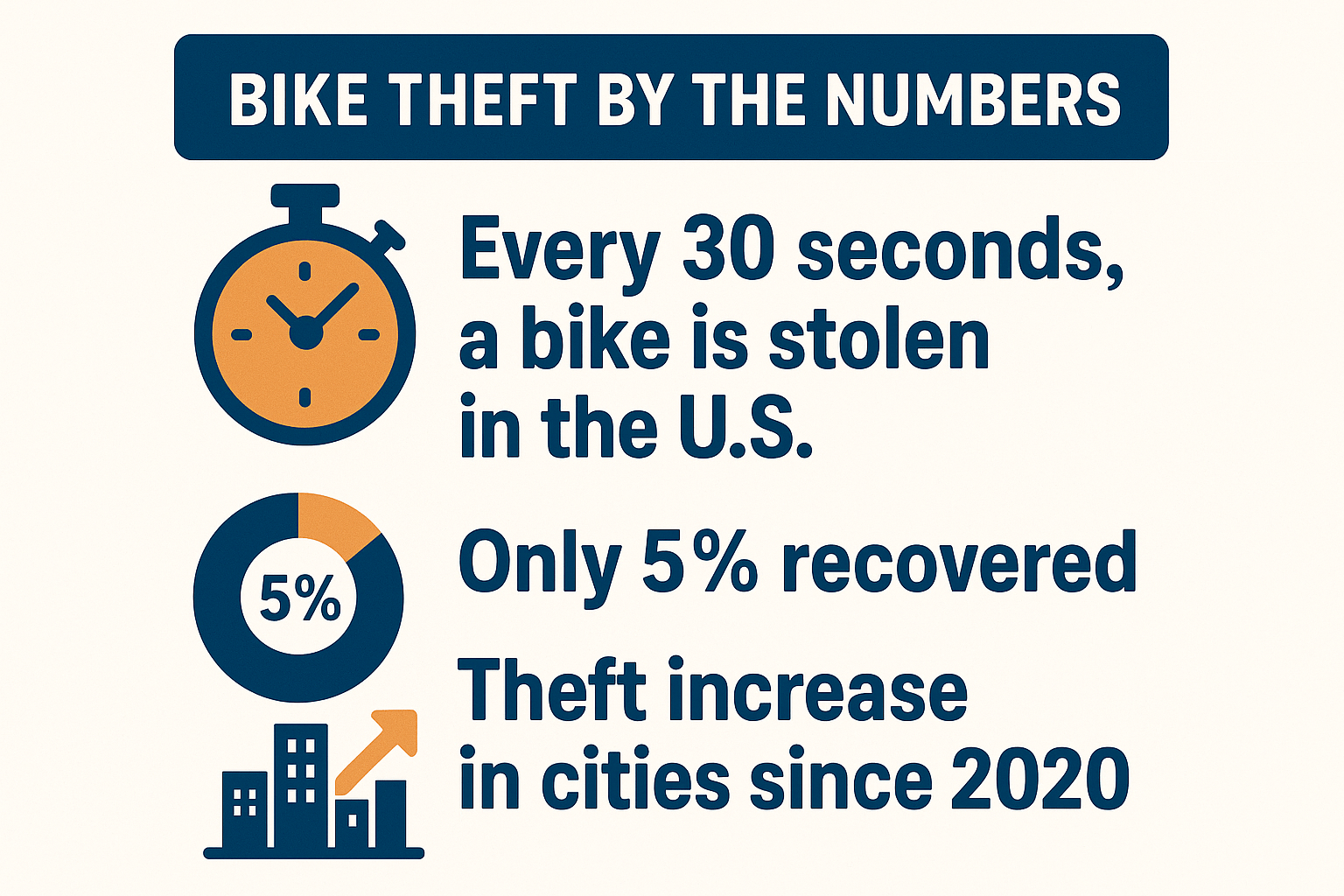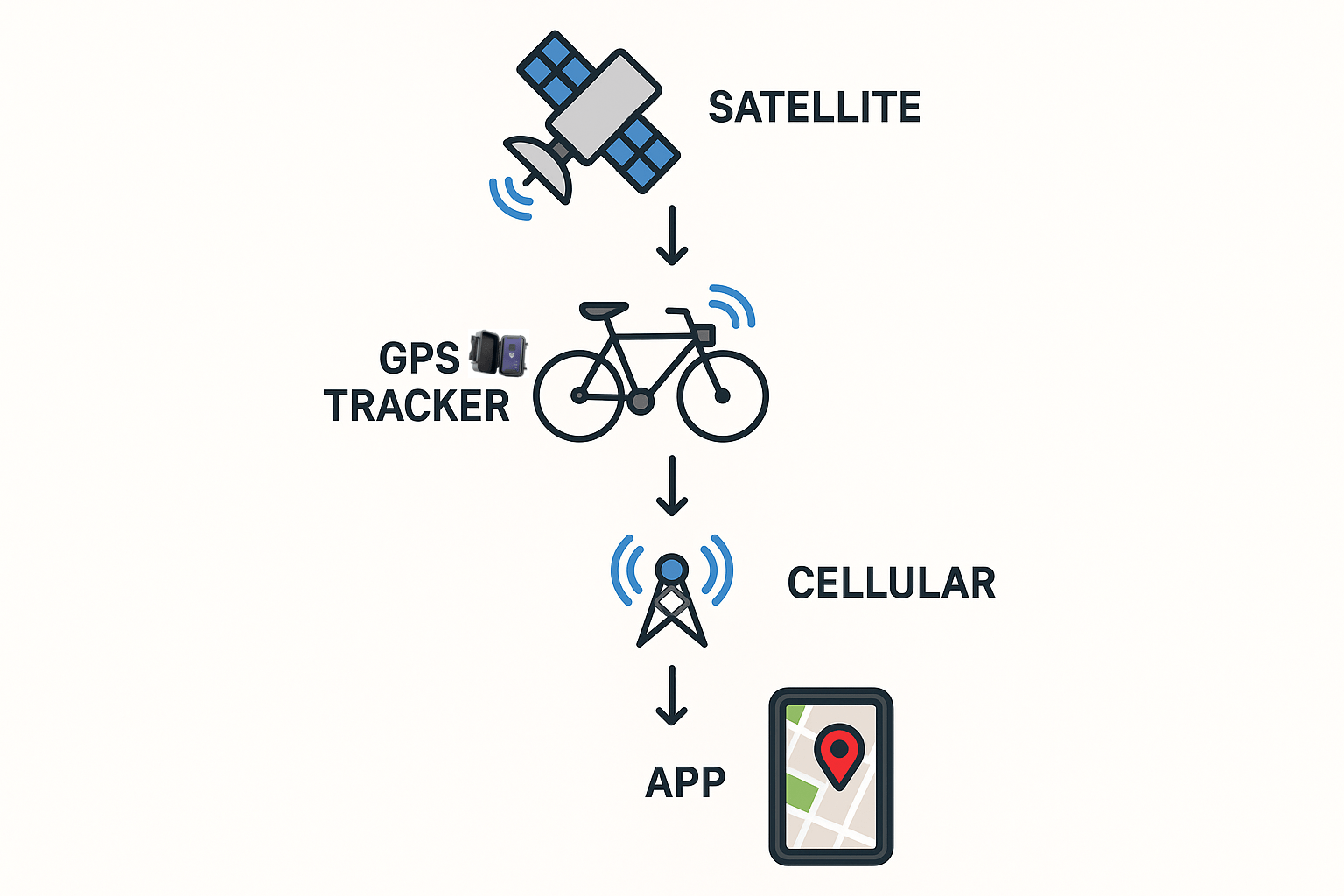GPS Tracker for Bike: Your Ultimate Guide to Keeping Your Ride Safe
Every 30 seconds, a bike is stolen in the U.S. That adds up to over 2 million bikes a year, and most of them are never recovered. Bike theft is also a major problem in the every country, with thousands of bikes stolen annually in cities, making GPS trackers essential for bike security in the U.S. as well. If you rely on your bicycle for commuting, training, or recreation, this isn’t just a statistic; it’s a daily concern.
![]()
That’s where a GPS tracker for your bike comes in. As the founder of BrickHouse Security, I’ve tested GPS solutions for over 15 years and let me tell you, bike trackers have come a long way. They’re now smaller, smarter, and more affordable than ever. Whether you’re locking up on a city street or leaving your mountain bike at the trailhead, a discreet GPS tracker is your best defense against theft and your best chance at recovery.
What Is a GPS Bike Tracker and Why Do You Need One?
A bike GPS tracker is a compact, discreet device that attaches to your bike and uses GPS, cellular, and sometimes Bluetooth or Wi-Fi signals to pinpoint its location in real time. GPS bike trackers use advanced gps technology to provide accurate, real-time gps location data. If your bike is moved or stolen, you’ll know instantly and you can track its real-time location directly from your smartphone or desktop, from anywhere in the world.
Top Reasons to Use a GPS Tracker for Your Bike:
- Theft Protection: Get real-time alerts the moment your bike is moved.
- Location History: Review past routes and stops great for training or accountability.
- Peace of Mind: Know where your bike is at all times, even when you’re away.
- Fleet Monitoring: For businesses or bike-sharing programs, track dozens of bikes at once.
- Additionally, enjoy access to dedicated customer support and optional insurance programs for extra security.
Bike Theft Is on the Rise: Know the Stats
 Only 5% of stolen bikes are recovered, according to the National Bike Registry. In major cities like New York, San Francisco, and Chicago, bike theft is up over 25% since 2020.
Only 5% of stolen bikes are recovered, according to the National Bike Registry. In major cities like New York, San Francisco, and Chicago, bike theft is up over 25% since 2020.
A quality bike can cost anywhere from $500 to over $5,000, making them high-value, easy targets.
Recovering a stolen bike without advanced tracking solutions is extremely difficult, as traditional methods rarely lead to successful retrieval. That’s why GPS tracking isn’t a luxury anymore it’s a necessary layer of security. - Source
What Features Should a GPS Tracker for Bike Have?
There are many devices on the market designed to help secure your bike, from dedicated GPS tracking units to smart tags and Bluetooth-enabled options. Choosing the best GPS bike trackers involves considering several key features to ensure effective theft recovery and reliable performance.
Here’s what I look for when personally testing trackers for our customers:
1. Real-Time GPS Tracking
- Precise location data, updated every 10–30 seconds.
- Typical range for real-time GPS tracking devices is unlimited as long as there is cellular coverage, allowing the device to reliably transmit location data over vast distances.
- Cloud-based history so you can see where your bike has been.
2. Motion & Tamper Alerts
- Get notified the second someone tries to move or tamper with your bike. Some trackers feature an audible alarm that sounds when unauthorized movement is detected, helping to deter theft. You are immediately alerted via the app when suspicious activity is detected, ensuring you are promptly alerted to any potential threats.
3. Long Battery Life
- Some trackers offer 2-4 weeks of battery on a single charge, or even solar-powered options.
4. Discreet Design
- Look for a little device with a slim profile that can be easily hidden in tail lights, seat posts, or bottle cages. This keeps the tracker out of sight, so thieves won’t even know it’s there.
5. Geofencing
- Set virtual boundaries and get alerts when your bike leaves a designated area.
- Note: Geofencing features depend on a reliable network connection to send alerts.
6. Mobile App Access
- Easy-to-use apps for iOS and Android make monitoring your bike simple from anywhere. A strong connection between the tracker and your app is essential for reliable updates. Many trackers are compatible with both Android and Apple devices, providing maximum flexibility for users.
Best Places to Hide a Bike GPS Tracker
Your GPS tracker is only as effective as its placement. Here are smart, stealthy locations:
- Inside the handlebar stem (some trackers require a special tool for installation, which is often supplied with the product to fit the tracker inside the handlebar end)
- Within the seat tube or seat post
- Hidden in the rear reflector or tail light
- Mounted in a dummy water bottle or bottle cage compartment
- Attached behind the water bottle cage (a strategic location that keeps the tracker hidden and accessible for maintenance; use zip ties to securely fasten the tracker so it doesn't rattle or interfere with the bottle)
- Tucked under the saddle
After installation, putting the tracker into operational mode is usually straightforward just follow the included steps to activate and start tracking.
Pro Tip: The more discreet, the better. A visible tracker is easy to remove.
Top GPS Trackers for Bikes in 2025 (Tested & Recommended)
1. Spark Nano 7 with Magnetic Case
- Real-time 4G GPS tracking
- Compact enough to fit under a saddle or inside a pouch
- Battery life: Up to 140 days
- Geofencing, speed alerts, and live tracking via app and computer
2. Tracki
- Real-time 4G GPS tracking
- Portable
- Battery life: Up to 7 days
- Geofencing, speed alerts, and live tracking
We personally test every model to ensure it stands up to real-world conditions and real-world thieves.
Who Should Use a Bike GPS Tracker?
Whether you’re a daily commuter or a fleet manager, GPS tracking can make a real difference:
- Commuters: Protect your bike while you’re at the office, gym, or coffee shop.
- Delivery Riders & Gig Workers: Ensure your bike is secure during shifts and recover it fast if it’s stolen.
- E-Bike Owners: Your high-value investment deserves professional-grade protection.
- Schools & Universities: Track bike fleets issued to students or staff.
- Law Enforcement: GPS data can support investigations and boost recovery rates.
How Bike GPS Tracking Works: Explained Simply
Think of gps bike trackers like a Find My iPhone but for your bike. These gps bike trackers use a combination of satellite, cellular, and app technology to provide real-time updates. Here’s how it works:
 Satellite GPS pinpoints the location.
Satellite GPS pinpoints the location.- Cellular networks send that location to your app.
- You view the bike’s real-time location on your phone or computer.
- Optional: Set geofences, view travel history, or get motion alerts.
No tech background needed setup takes just minutes.
Local Recovery: How GPS Helps Police Retrieve Stolen Bikes
We’ve helped thousands of customers across the U.S. track and recover stolen bikes. The key? Actionable, shareable GPS data. Police can respond quickly with a real-time location and get your bike back sometimes within hours.
We recommend:
- Filing a police report immediately and providing the gps location to law enforcement.
- Sharing app screenshots or live tracking links.
- Never confront a thief yourself let law enforcement handle it.
Final Thoughts: Protect What Moves You
At BrickHouse Security, we believe your bike deserves the same protection as your car or phone. A GPS tracker is a small investment that can save you hundreds or even thousands by preventing theft or aiding recovery.
Whether you're in a big city or a small town, your bike isn’t just a mode of transportation. It’s your ride, your freedom and worth protecting.
FAQs: GPS Tracker for Bike
Can a thief disable the GPS tracker?
Most quality trackers are discreet and hard to find. Even if discovered, many send a final location ping when tampered with.
Will the GPS tracker drain quickly?
Our best models offer 140 days on a charge or connect to an bike battery (if there) for always-on protection.
Is a monthly service required?
Yes, because GPS uses cellular networks to report location.
Can I use one GPS tracker for multiple bikes?
You can move the tracker, but we recommend one per bike for consistent security.
Are bike GPS trackers legal?
Absolutely, tracking your own property is 100% legal in all 50 states. Check GPS Tracking Laws Explained article.
What’s the difference between a GPS tracker and a Bluetooth tracking device like Tile?
A GPS tracker uses satellite and cellular networks to provide real-time location updates anywhere, making it ideal for tracking bikes over long distances.
A Bluetooth tracking device, such as Tile, relies on proximity alerts and only works within a short range typically up to a few hundred feet by connecting to your phone or other nearby devices. Bluetooth tracking devices are best for finding misplaced items nearby, while GPS trackers are designed for broader, real-time tracking.
Ready to Track Your Bike?
Explore our full line of Bike GPS Trackers and get free shipping today.
Have questions? Call our U.S.-based security experts anytime.
Posted by Todd Morris on Aug 15th 2025


